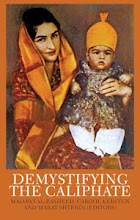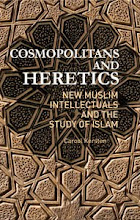This week's edition of
Qantara, the Germany-based website covering current political, cultural and intellectual affairs in the Muslim world draws attention to the work of the Moroccan philosopher and poet
Mohammed Aziz Lahbabi (1923-1993) and the latter's important contributions he has made to developing an Islamic-philosophical anthropology through his 'Muslim personalism'.
 |
| Mohammed Aziz Lahbabi (1923-1993) |
The German theologian and philosopher, Pastor
Dr Markus Kneer, has recently published an annoted German translation of Lahbabi's
Le Personnalisme Musulman under the title
Der Mensch: Zeuge Gottes: Entwurf eine islamischen Anthropology. In an interview he discusses some aspects of Lahbabi's work. Motivated to find a new way of engaging in Muslim-Christian dialogue, Kneer was looking for a Muslim thinker who could be presented with reference to Western anthropologies:
It seemed to me that localising what is to a great extent a Christian and Occidental concept of the individual within a Muslim context harboured the potential for a dialogue on the Christian and Islamic images of man – potential that should by all means be tapped. Lahbabi's "Muslim personalism" consists of just such an articulation of the human individual from Islamic sources. His points of reference in European philosophy are the personalism of Emmanuel Mounier (1905–1950) and Jean Lacroix (1900–1986) as well as the life philosophy of Henri Bergson (1859–1941).
Admitting that Lahbabi's ideas are very much grounded in the intellectual climate of the 1950s and 1960s, Kneer argues that, against the dramatic changes in the political landscape in North Africa, the time is ripe for a new appreciation of some of the ideas that had come to fruition in that time frame:
Today, personalism has largely been replaced by other discourses. Nevertheless, contemplation of the human as person is more intense today than in past decades, and what Paul Ricœur already predicted thirty years ago now seems to be coming true: "Personalism will die, but the person will return!"
This concept after all bundles together other values that are of great importance for the articulation and ethical analysis of human life: e.g. dignity, freedom, responsibility. And I think it's no accident that in recent official publications of the Arab League on the subject of human rights the Arabic equivalent of person, "shakhs", frequently appears.

Although two generations have passed since North Africa shook off the yoke of political imperialism, the Muslim world's intellectual emancipation has only been partially realized. Recently, its progress has been obstructed by the positing of unhelpful theses, such as Francis Fukuyama's 'The End of History', and dangerous polarizing ideological paradigms for a new post-Cold War world order, like the 'Clash of Civilizations', advocated by the likes of Samuel Huntington. It seems in many parts of the Muslim world the time is ripe for challenging these remnants of Western hegemonism, thus giving new currency to the ideas Lahbabi developed a few decades ago. As Kneer explains:
The historical and practical reasons why Lahbabi chose to analyse the process of becoming a person can be found in the identity crisis experienced by the colonised populace during the colonial era – in particular by the intellectuals. Lahbabi described how the colonial system had depersonalising effects for him and many others. Instead of experiencing language, communication and mental life as fields for personalisation, his generation suffered from speechlessness, non-communication and a feeling of inner emptiness. He wondered for a long time whether he was a person equal to the others, in other words, to the Europeans. The role of the Other in becoming a person and a human is thus not unproblematic.
The awareness of this philosophical problem is also reflected in Lahbabi's stance towards the place of reason in human thinking and how this can be accommodated within a Muslim Personalist philosophy:
Lahbabi is not talking about an absolute reason of the word, divorced from the religious context, but rather a reason that illuminates and lends dynamics to this context. In other words, ijtihad, the term used in Islamic theology to describe the personal and rational adoption of faith, must be rehabilitated as the fundamental method of theological work. Lahbabi's profound criticism of taqlid, the blind mimicking of and adherence to opinions passed down by the great Muslim scholarly authorities, is connected with this stance. Only shahada (profession of the one and only God, the Muslim creed) that reflects true ijtihad has personalising value, says Lahbabi.
With his dynamic concept of reason, Lahbabi takes up a position within value hermeneutics that mediates between the cultural and religious sources of values and their universal validity. In the process of transcending the bounds of the self, culturally inflected values become understandable against the horizon of other value traditions, and their universality can be tested. One-sided culturalism or universalism is not possible with Lahbabi.
Read the full article by clicking
here.
 |
| Dr Marien van den Boom |
Kneer is not the first Western scholar to draw attention to Lahbabi's thought. In 1984, the Dutch scholar Marien van den Boom published a PhD thesis in which he juxtaposes Lahbabi with the Egyptian philosopher Hasan Hanafi. Written in Dutch,
De Bevrijding van de Mens in Islamitisch Perspektief (The Liberation of Man from an Islamic Perspective) unfortunately went largely unnoticed. To my knowledge, it was -- and still is -- the only detailed examination of the anthropological turn by two Muslim philosophers, who are not only united by this anthropocentric focus, but also by their ambition to develop a kind of Islamic liberation theology as a contribution to the liberation of the entire 'Third World'.
Of course, other thinkers from the Muslim world, such as Hichem Djait, Mohammed Arkoun, and -- in Indonesia -- Nurcholish Madjid have also developed personalist and humanist ways of thinking, drawing on concepts such as Kardiner's 'basic personality structure' or advocating new epistemologies that make a clear distinction between theological and anthropological approaches to the study of religious phenomena. For a more detailed discussion of the contributions of Arkoun, Hanafi and Madjid to these debates, see my
Cosmopolitans and Heretics, which has just been released by Columbia University Press.

















